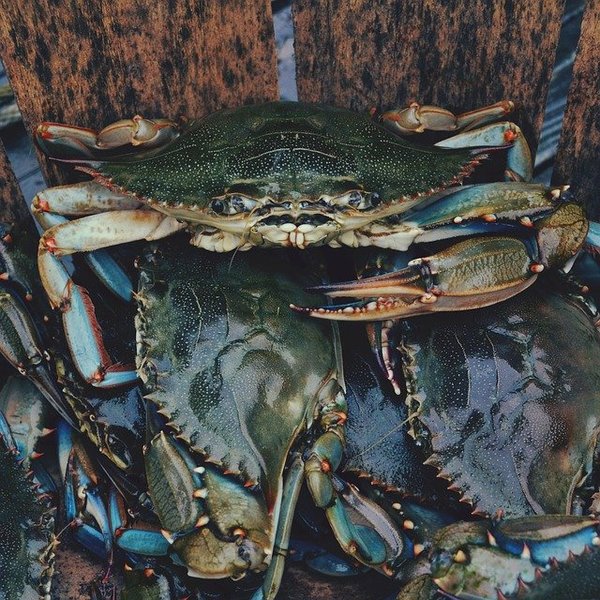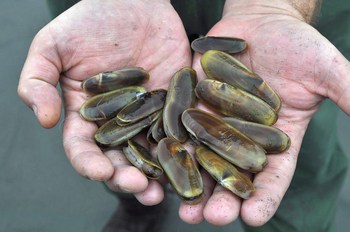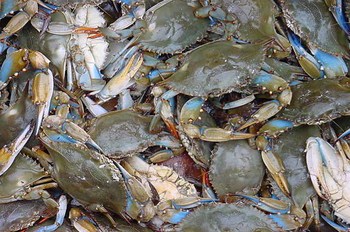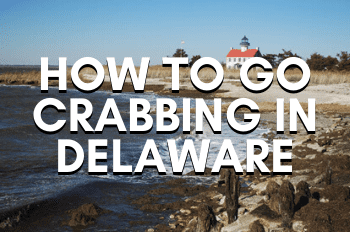How To Go Crabbing (Step-by-Step Guide)
So, you want to take on recreational crabbing. You’re in luck! Crabbing is a great pastime for people of all ages. Whether you’re looking for a fun way to spend the day on the water, or you’re on the hunt for a delicious crab dinner, crabbing is the way to go.
The activity may look simple at first glance, but it’s a little more complicated than throwing a trap in the water with fingers crossed. There are minor details and tips most guides and videos leave out which make or break a crabbing trip. After lots of research and personal experience, I came up with this how-to guide on crabbing.
To make things as simple as possible, I broke down crabbing into 12 easy steps sectioned into three phases: Crabbing Knowledge, Crabbing, and After The Catch. They’re straightforward enough to make crabbing obtainable for anyone without leaving out any important details. So, let’s dive into how to go crabbing for beginners.
Crabbing Knowledge
1) Make sure crabs are running and in season in your area.
If you want to go crabbing, you would probably want to know that there are actual crabs to be caught. If you go crabbing too early or too late in the year, you most likely will not catch anything. You need to go crabbing when crabs are in season in your area.
Blue crabs are in season from late spring to fall, while Dungeness crabs are in season from fall to the summer. The blue crab being more apt to warmer waters has a flipped season when compared to the cold-water-loving Dungeness crab.
In most cases, whatever dates your state’s crabbing season falls under is a good time to go crabbing. Just keep in mind that this is most-often a date set when a little over half of the state’s waterways are worth crabbing in.
Being within your state’s crabbing season is one thing, what really makes or breaks a crabbing trip is to go when crabs are running wherever you plan to go crabbing. A great way to find this information is through crabbing reports.
Crabbing reports can be found on crabbing forums. There, recreational fishermen will report their latest catch in all sorts of bodies of water. Through trial and error, these crabbers find out when crabs are running near you so you don’t have to.
I find my crabbing reports at Bluecrab.info. Take a look at the most recent crabbing reports in your state to find great crabbing spots and give you an idea of where is a good spot to go crabbing.
2) Know what type of crab you’re after.
Before you go crabbing, you need to know what you’re getting into. Crabbing methods differ based on what species of crab you’re after. For this reason, it’s important to know what crabs live in the body of water you’re crabbing in.
If you live in the United States, you will most likely be crabbing for either Blue crabs or Dungeness crabs.
Blue crabs live from Newfoundland to south of Brazil on the East Coast, while Dungeness crabs live from Alaska to central California on the West Coast.
Each side of the US has their own minor species of crabs available. The west coast has its rock crabs and the East coast has stone crabs in southern Florida. This article will be focusing on Blue and Dungeness crabs
Crabbing for blue crabs is a whole different ball game than Dungeness. For starters, blue crabs have smaller traps with thinner wiring. This is because the type of crab they are built for are much smaller which less-powerful pincers than the larger Dungeness crab and vice versa.
When shopping for crab traps, make sure it’s built for your species of crab. Don’t worry about this for now, I’ll get into that later on. For now, just know what type of crab you are after.
3) Read and write down your state’s recreational crabbing guidelines.
Crabbing regulations may seem like something to skim over, but in reality, they are very important for anyone going crabbing. Before you think to go crabbing, go to your state’s crabbing regulations to make sure what you are doing is legal.
Anyone can find their state’s crabbing regulations by going to Google.com and searching for: “(Your State) crabbing regulations”. For example, people who live in Maryland would search: “Maryland crabbing regulations.” Make sure to visit results which include a .gov domain, or are apart of your state’s wildlife department, for the most accurate information.
Key information you need to know is:
- Your state’s crabbing season.
- Any day of the week or time of day restrictions.
- Crab size and gender restrictions.
- Daily possession limits.
Find these four bits of information and write them down. It’s imperative that you know these bits of information. Otherwise, you could be fined hundreds to thousands of dollars.
Also, take note of anything else mentioned in your state’s crabbing regulations. These are the four most commonly broken rules by state.
If you don’t follow these rules, you’re sure to get fined by a DNR officer. There’s nothing worse than getting a hefty fine for breaking such palpable laws, so be sure to familiarize yourself with your state’s crabbing regulations.
I’ve put together a directory page of each state’s crabbing regulations. Click here, or below to see it for yourself.
4) Find a nearby spot to go crabbing.
You can go crabbing in any body of brackish or salt water. It’s easiest to go crabbing from a low-lying pier along calmer waters, but it’s also possible from a shoreline or beach. Crab pots, collapsible traps, and hand lines all work from a pier. Crab snares and crab pots work best from a shoreline.
I put together a complete list of crabbing spots in the United States.
- Public piers are labeled with a blue pinpoint.
- Bridges are labeled with a yellow pinpoint.
- Bodies of water and Boat ramps are labeled with a green pinpoint.
- Shoreline crabbing spots are labeled with a red pinpoint.
If you’re interested in a state-specific guide on where to go crabbing, I recommend you read my article: Where to go Crabbing – CrabbingHub.
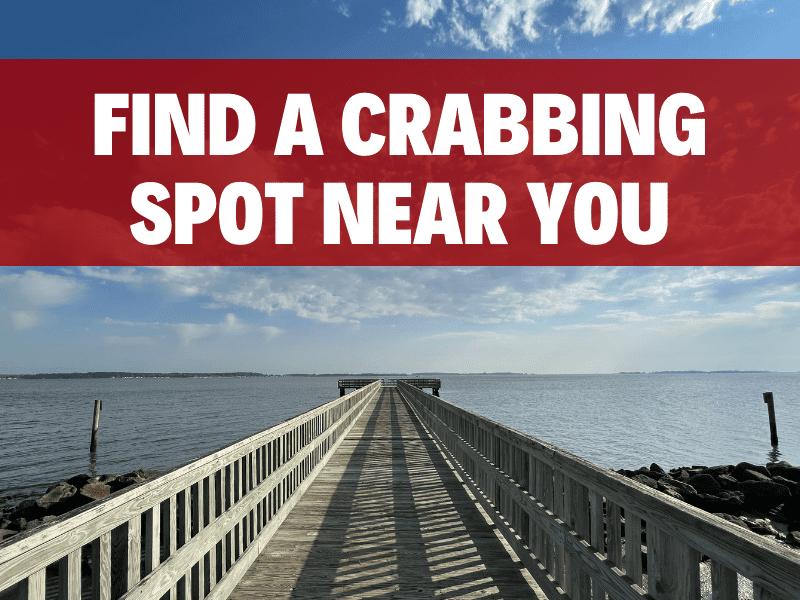
5) Plan your trip with the tides.
“When the water’s moving, so are the crabs. All you gotta do is catch them.”
– Taylor Whiteman @Crabbinghub.com
If you live on the West Coast, you may ignore this step. Dungeness Crabs do not use the tides to move around, which means they have little effect on crabbing.
Blue Crabs are smart creatures. Instead of relying on their legs to move around like other species of crabs, they use their two back fins to swim. Not only that, but they also utilize the tides to glide through the water much faster than they ever would using their tiny legs. This allows Blue Crabs to travel far distances and cover large areas of water.
Knowing this simple fact about Blue Crabs can be very beneficial to us recreational crabbers. We can utilize the times when the tides make blue crabs active in order to catch the most crabs in the shortest amount of time.
Your goal, as the crabber, is to catch crabs as they move with the tides. During incoming high tide, crabs are hyperactive and your traps will pull up more crabs than during slack tide.
The trick to utilizing the tides is to go crabbing when the tide is moving water from saltier waters towards you. Crabs tend to congregate near the shore in salty waters. So, when the tide brings that water to you, that’s when you want to go crabbing.
To get the tides for your area, you need to Google the phrase “tides for my area.” You’ll find plenty of tide websites. Find one that gives you a tidal chart.
It will look something like this:
With this information, we can plan the best day and time to go crabbing. You want a day where the tide:
- Is experiencing the largest change from high to low tide
- Has the shortest slack tide (the time between high and low tide)
- Is within your state’s allotted timeframe to go crabbing.
For this map, I would choose to go crabbing on June 17th from 1 PM to 7 PM. During this time, the tide experiences a 2.5 ft change, the greatest change during this 3 day period. It’s within Delaware’s crabbing regulations (you cannot crab at night in Delaware).
Is incoming high tide better than incoming low tide for crabbing?
This depends on where you are. If you are crabbing in waters that are more inland, you would want to go crabbing when the water is approaching high tide. During that time, the water is moving inland from saltier waters, which contain more crabs than freshwater runoff from the mainland.
If you’re near the mouth of an estuary or much closer to the ocean, crabbing during incoming low or high tide will be just as effective. Enough crabs congregate in that area, to begin with, so the incoming low tide will also bring a slew of crabs waiting to be caught.
If you want to be smart about crabbing, look up the tides for your area beforehand and go crabbing when the time is right. You’ll end up with more crabs and an overall more enjoyable experience.
6) Find the right type of bait to go crabbing.
The first question any beginner crabber’s mind is what they should use for bait. Let me answer that for you.
In nature, they will eat algae and other types of nutrients along the seafloor. They are bottom feeders, and will eat whatever they can get their claws on.
It’s pretty difficult to fill your bait cages with algae. Also, while crabs may eat a slice of pizza, it is not the most effective type of bait. The best bait for your crab traps is oily or greasy meat.
The top three popular crabbing baits are:
- Chicken
- Fresh fish
- Razor clams
These three types of meat are not the most natural source of food for crabs, but they do an incredible job of catching crabs. Ask any crabber, and he or she will most likely recommend that you use one of the three baits.
Not only are these baits effective, but they are also cost-efficient. You can buy plenty of chicken, fish, or clams from your local bait shop or grocery store.
How much bait you will need depends on how much crabbing you plan on doing. If you plan on undertaking a normal 3 to 6-hour trip with half a dozen traps, 1-3 pounds of meat should do the trick. I always bring some extra in a cooler just in case.
There are plenty of other types of crab meat you can find lying around your house. If you want a more in-depth article on crab bait, I recommend you check out my article What’s The Best Bait For Crabbing.
7) Gather crabbing equipment for your trip.
To make your trip successful, it’s important that you bring everything that you need for a day of crabbing. There are some essentials that every beginner crabber should not leave the house without, as well as some optional items which make some tasks just a little more convenient.
I go over all of these items and more in my article: Here Are 20 Things You Should Always Bring To A Crabbing Trip.
The Necessities
If you’re going crabbing, I would not leave the house without these three items. They’re essential to a crabbing trip. Let me tell you why.
If you’re going crabbing, you need to bring:
- More than one crab trap. To up your chances of catching crabs, you should bring more than one trap. Each state has its own regulation on how many of each trap you can bring. I recommend bringing as many as you can manage. That way the crabbing never gets slow and you will end up with more crabs.
- Your preferred crab bait. You can’t catch any crabs without some bait. I gave you my top three crab baits in the previous steps. You will need about .5 lbs of bait per trap for a 3 to 6-hour crabbing trip. Bring that amount, plus a little more just in case. A cooler should keep your bait fresh and ready to go into your traps.
- A cooler with ice and a spare towel. This last item is important because it keeps your crabs alive after you catch them. I’ll go into more depth on keeping crabs alive in step 10.
Besides the necessities, I picked out some crabbing equipment that would come in handy for anyone going crabbing. I would especially recommend these items if it is your first time crabbing to make the experience a little easier.
Some useful crabbing equipment includes:
- A bait cage. Crabs have been known to steal bait. A bait cage is a small wire cage that you store bait inside. You can secure this in your trap to keep your bait safe from any bottom feeders. If you plan on using collapsible traps (I’ll get into what they are in the next step), I highly recommend using a bait cage.

- A bushel basket. Most states regulate their daily possession limit by the bushel. The best way to know that you have a bushel of crabs is with a bushel basket. I got one for just over $10 on Amazon, which has plenty of durable bushel baskets. Click here to go shopping for bushel baskets on Amazon.com. Unless you want to count out and weight your crabs, I would recommend investing in a bushel basket. Pro tip: You can throw a damp towel over your basket to keep your crabs alive for several hours.
- Tongs. I’m sure you’re aware that crabs pinch. Trust me, they do. It hurts. A great way to avoid a pinched finger is a nice set of kitchen tongs. I recommend buying one specifically for your crab trips because your tongs will start to smell like crabs.
- Thick gloves. Another way to avoid a nasty crab pinch is with thick gloves. Some outdoor retailers and fishing supply stores sell thick gloves made for dealing with crabs. If you’re new to crabbing, I recommend you pick one up.
- A bucket. Whenever I go crabbing, I constantly find myself needing a spare bucket.
- Extra rope. It’s always better to have extra rope than to not have enough. Bring some extra.
To make your crabbing trip as entertaining as possible, I recommend that you bring some extra supplies besides the crabbing necessities. You need something for when the crabbing gets slow. Hopefully, it doesn’t, but just in case it does. A few recommendations include:
- Your favorite portable folding chair. If you’re crabbing from a pier or shoreline, a folding chair is a great way to sit back and enjoy crabbing. I never go crabbing without one.
- A fishing rod. If the crabbing gets slow, people usually bring a fishing rod to pass the time. You’re already by the water, so you might as well go fishing.
- A good book. If you’re like me and love a good book, I recommend bringing one along for the trip. There’s nothing like reading a nice book while crabbing from your local fishing pier. At the moment I’m reading Pet Sematary by Stephen King and I love it. Be sure to leave your favorite book in the comments.
Going shopping for crabbing supplies? Take a look at my crabbing supplies checklist. It’s full of the equipment I use and I know works through personal experience.
Crabbing
Now that you are packed and ready for your crab trip, you need to know how to actually go crabbing. There are several various methods that are easy to pick up. Each one has its own strengths and weaknesses. Let’s go over each crabbing method, which one is best for you, and how to do it.
8) Go crabbing with your preferred method or trap.
The time has come for you to pick a method and go crabbing. I took the five most popular crabbing methods and did a quick comparison.
Each trap works better in its own way. Some are cheaper and simpler than others, while some require more time and money.
To help you narrow down whichever method or combination of methods you want to use, I’ll give you an idea of what you can use if you’re crabbing from shore, from a pier, or from a boat.
| Crab Trap | Works from Shore | Works from a Pier | Works from a Boat |
| Hand Line | Yes | Yes | No |
| Ring Net | No | Yes | Yes |
| Collapsible Traps | No | Yes | Yes |
| Crab Pot | Yes | Yes | Yes |
| Trot Line | No | No | Yes |
So, there are your options. If you’re crabbing from shore, a hand line or a crab pot will work best. If you’re crabbing from a pier, hand lines, ring nets, collapsible traps, and crab pots will work best. I think you’re getting the idea.
But what are these traps? How do they work and how can I use them? Let’s talk about each trap and how to use them.
Hand Lines
Hand lines are a fancy name for the classic string and chicken neck method. The concept is simple: lure crabs with some bait then scoop them out of the water with a net. Seems simple enough, right? It is. Here’s how to do it in a nutshell.
How do I go crabbing with hand lines?
To go crabbing with hand lines, tie a piece of bait to the end of a string and throw it into the water. Eventually, a crab will be drawn to your bait. The string will be pulled taught, signaling there’s a crab on your line. When that happens, slowly pull the bait towards you and scoop the crab with a dip net.
This is the most basic form of crabbing. I highly recommend using hand lines to go crabbing if you are a beginner. It’s the cheapest method and it truly gives you an authentic crabbing experience.
Ring Nets
Ring nets go hand in hand with hand lines as go-to beginner crabbing methods. They’re inexpensive and simple enough to make crabbing accessible for anyone. You can find ring nets at some beach shops, most bait & tackle shops, and nearly all general retail stores near the coast. In the summer, you’ll find them for sale at your local Walmart.
So, how do I go crabbing with ring nets?
To go crabbing with ring nets, Secure a piece of bait to the center inside of the small “basket” your ring net creates when held above the ground. Afterward, lower the net into the water and wait for a crab to find your bait. After 10 to 15 minutes, pull the net to the surface and see if you have caught any crabs. Repeat these steps until you catch a crab dinner.
Collapsible Traps
Collapsible traps are very similar to ring nets. They have the same concept: drop the trap in the water and pull it up once a crab is on your bait. The only difference is that these traps are made out of wire mesh instead of cotton netting.
Two of the most popular collapsible traps include box and star traps. One is shaped like a star, while the other is shaped like an unfolded box. You with me?
They are very simple to maneuver. You will want to be above a fairly deep section of water, at least 5 feet. You secure some bait to the center of the inside of the trap and lower it to the bottom. When it hits the bottom, the trap will fold open allowing crabs to go for the bait.
Every so often, it’s your job to pull the trap up and see if you caught a crab. Star traps will fold into miniature pyramids and box traps will fold into squares that crabs cannot escape from. They’re very effective at catching crabs, and a dozen of them in action will catch you a bushel in no time.
Crab Pots
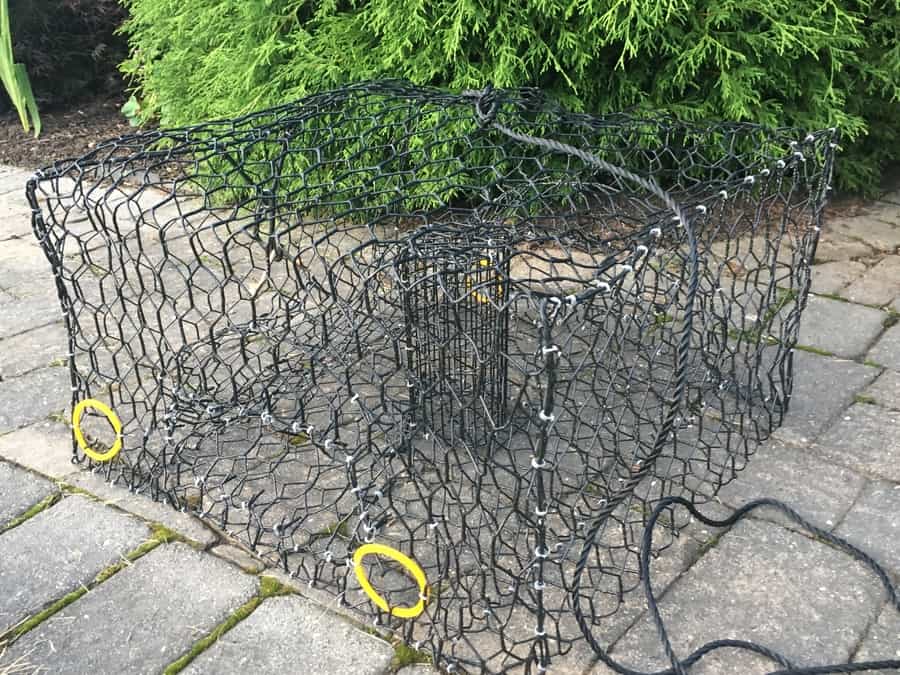
This is your classic crab pot you imagine when you go crabbing. You’ll see most commercial crabbers use this type of trap.
It’s been a part of the crabbing industries for centuries. Crab pots are specially-built cages that use crab’s instincts to trap them. If you want a full explanation of how crab pots work, check out my article: How Crab Pots Work (With Pictures!).
Crab pots are especially useful as they can be plopped in any body of crab-filled waters and do its magic. It’s the only way to go crabbing that’s completely passive. All you have to do is set the trap and come back later.
So, how do I go crabbing with crab pots?
First, you need to fill the bait cage with enough bait to last however long you plan to leave the trap. After the bait cage is secured, tie the trap to at least 30 ft of rope with a buoy on the end so you do not lose your trap. Lower the trap into the water and come back later to collect your catch.
Trot Lines
Last, but definitely not least, you have trotlines. If you have a boat, this is my recommendation for crabbing. Not only is it the most fun, but it is also the most efficient way to go crabbing.
This method is a bit more complicated than the previous ones. It required a lot more prep work, but it pays off in the end.
A trot line is 100 to 5000 ft of rope (size depends on state regulations) with bait tied to the line every 2 to 6 feet. Each end of the trot line is attached to an anchored buoy to keep it in one place. The line between the two buoys lays flat on the riverbottom, and is usually weighed down by the bait and some chain on both ends.
A crabber will set this contraption in a small section of water. After waiting a few minutes for crabs to be attracted to the bait, it’s time for the crabber to use the trot line. Using a prop stick (a small u shaped pole attached to the crabbing boat) the trot line is guided from the bottom to beside the boat. From there, whoever’s on the boat will scoop up the crabs with a dip net as they surface with the baited line.
It’s a bit complicated compared to the other methods, but it’s a lot of fun. You’re going to need either a boat or a sturdy kayak to go crabbing like this. If you’re a beginner, I would stick to one of the previous methods.
As you catch your crabs, make sure that you collect them in an empty container that is shaded from the sun. There should be no water in this container. This will cause your crabs to suffocate.
9) Follow your state’s crabbing guidelines while crabbing
With the excitement of crabbing, it can be easy to forget your state’s crabbing regulations. Remember the information I asked you to write down in step 1? Now is when it comes into play.
You’re going to need to remember two bits of information:
- Daily possession limits.
- Minimum crab size.
You can only keep a certain number of crabs that fit a certain size. These regulations vary by state, so make sure you check your state’s crabbing regulations and follow them. Otherwise you’ll be playing hundreds of dollars in fines over a slightly undersized crab.
After The Catch
By now, you should be finished with your day of crabbing. Don’t fool yourself, you’re only halfway done crabbing. Now that you have caught your crabs you need to keep them alive, cook them, and eat them.
10) Keep your crabs alive and well until you’re ready to cook them.
Forget catching crabs, keeping them alive can be the most tricky part to crabbing. It’s the part that most beginners get wrong, which is why I made it a step for this guide.
Remember the cooler with ice Here’s where it comes in handy. You’re going to use either method to keep your crabs alive before you cook them. It’s very important that crabs stay alive before being cooked. If a crab dies, the bacteria from its guts and shell quickly turn the crab’s meat bad. So, unless you want to eat mushy, foul-tasting crab, you need to keep them alive.
If you’re using a cooler with ice, make sure you are using a cooler with a drainage plug. You need to pull the plug, then line the bottom of the cooler with ice. It’s smart to put the cooler on a slight decline so the water has no choice but to run out the cooler’s drainage plug. From there, place a towel over the ice. Not doing so may kill the crabs from the ice’s harsh cold. Now, you’re set to place your crabs in the cooler. The cold will slow them down and put them in a dormant state. Close the lid but keep it open just a tad with a small stick. You want the crabs to have some fresh air. Make sure your cooler is not in direct sunlight.
If you want a more in-depth guide to keeping crabs alive, check out my article: How To Keep Blue Crabs Alive and Well. Don’t take the title too close to heart, it works for Dungeness Crabs as well.
11) Cook your crabs.
You did it! You’re in the home stretch. You took some flimsy traps and a few pieces of bait and turned it into a crab dinner. All you need to do now is cook them.
Everyone cooks their crabs differently throughout the US. I am from the Delmarva area, so I steam my crabs like a sane person. I can’t imagine boiling a crab. Yuck!
I’ll give you a basic recipe for steaming crabs. You need a pot large enough to cook your catch. If you caught enough crabs, you can split your catch into several cooks. Just make sure you cook all of your crabs. The longer you wait, the sooner your crabs are going to die.
You will need a large pot and a raised rack. It’s important that the crabs do not touch the liquid while cooking.
Steamed Crabs Ingredients:
- 1 dozen live crabs
- 1 cup vinegar
- 1 cup beer
- 3 tablespoons salt
- 3 tablespoons seafood seasoning
Add equal quantities of vinegar and beer just below the level of the rack. Next, layer crabs on top of the rack while seasoning each layer. I use Old Bay to season my crabs as all crabbers should. As you can tell, I’m a Marylander at heart.
This recipe assumes you are cooking 12 crabs, so modify it according to how many crabs you caught. You can use as much beer and vinegar as you please, just as long as it is in equal parts and stays below the pot’s rack.
Steam the crabs until they are red. This is usually around 15 minutes.
12) Serve your crabs as a nice meal.
Once your crabs are done steaming, you are done! Serve your crabs with a few side dishes and some melted butter. Corn on the cob, fried vegetables, and french fries are a few of my favorites. Trust me when I say crabs taste the best when you catch them yourself.
I hope you enjoyed my crabbing guide. Be sure to leave a comment telling me about your experience crabbing. I’ll be sure to answer any questions you have have. Happy crabbing!


